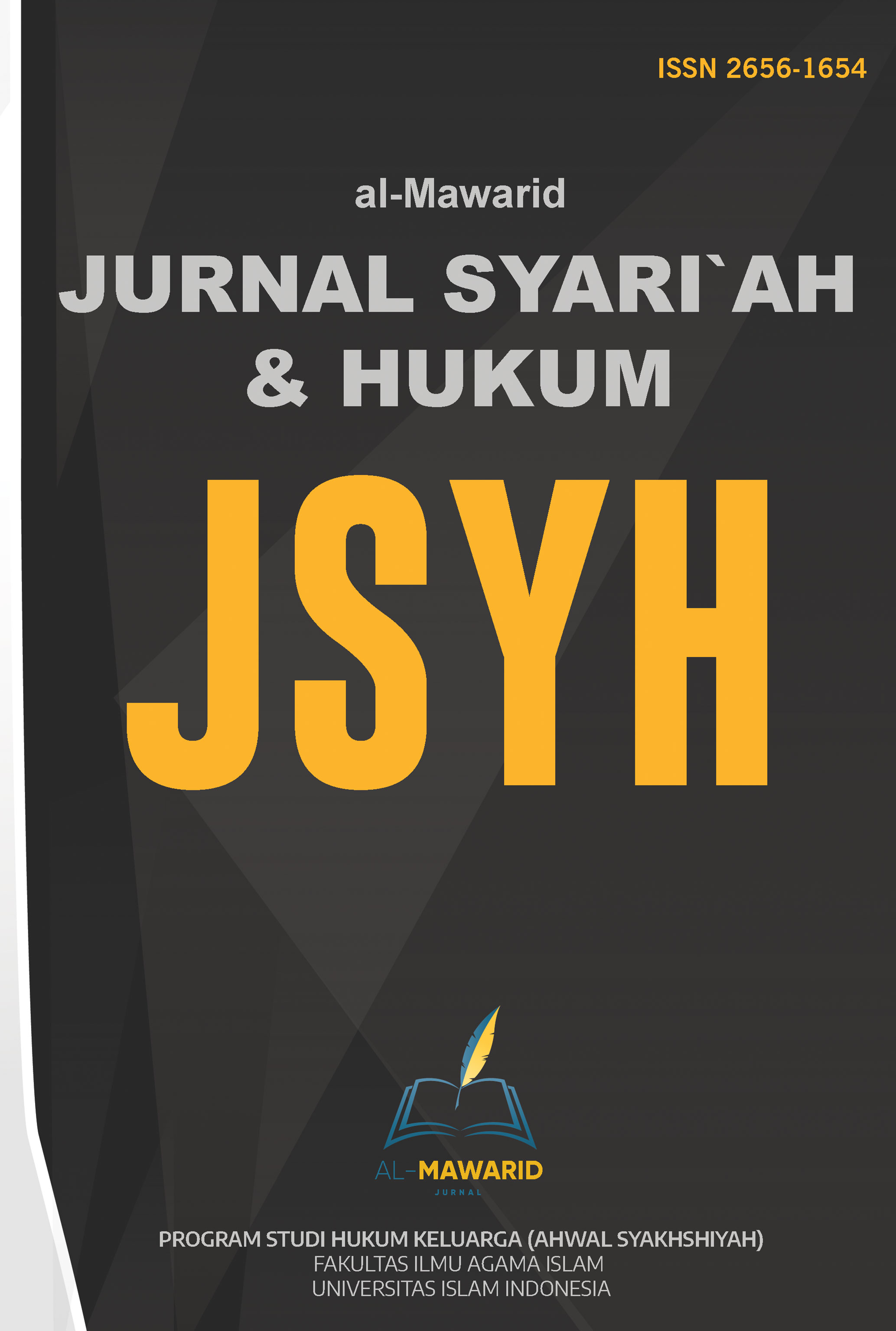Main Article Content
Abstract
This study aims to determine cash waqf in the view of sharia economic law in the era of the industrial revolution 4.0. The understanding of the Indonesian people regarding cash waqf is still minimal even though this waqf has excellent potential for the welfare of the Indonesian people. Regarding research from the perspective of Islamic economic law on cash waqf in the era of the industrial revolution 4.0, no one has researched it. The method used is literature research, qualitative, with statutory, historical, comparative, and conceptual approaches, and this research is normative. The view of Shariah economics in Indonesia regarding cash waqf is carried out by Law No.41 / 2004 concerning waqf in which moving objects are in the form of “movable object waqf” which is manifested in the form of money. Waqf money in Indonesia in the era of the Industrial Revolution 4.0 can prosper the economy of the people and the country. Waqf is positioned as social worship, wherewith waqf in Law no.41 / 2004 concerning waqf article 1 it is explained that waqf is the act of a wakif to separate or give up part of his property to be used forever for worship purposes and for welfare purposes according to Islamic sharia.
Article Details

This work is licensed under a Creative Commons Attribution-NonCommercial-ShareAlike 4.0 International License.
References
- UU No.41/2004 tentang Wakaf
- Ibrahim, J. (2007). Teori dan Metodologi Penelitian Hukum Nornnatif. Malang: Bayu media Publishing.
- Nasution, B. J. (2008.). Metode Penelitiann Ilmu Hukum. Bandung: Mandaar Maju.
- Abdullah, J. (2018). Tata cara dan pengelolaan wakaf uang di indonesia. Ziswaf: jurnal zakat dan wakaf, 4(1), 87–104. https://doi.org/10.21043/ziswaf.v4i1.3033.
- Adwi, Farly, and Roem Syibly. 2019. “Islamic Law Studies on the Use of Infak Fund for Land Waqf.” Al-Mawarid Jurnal Syari’ah Dan Hukum 1 (1): 61–72. https://doi.org/10.20885/mawarid.vol1.iss1.art4.
- Asmara, T. T. P., & Abubakar, L. (2019). Juridical Study on the Optimization of Cash Waqf Management by Islamic Banking in Indonesia. Padjadjaran Journal of Law, 6(3), 427–445. https://doi.org/DOI: https://doi.org/10.22304/pjih.v6n3.a1
- Baidowi, A., & Salehudin, Moh. (2021). Strategi Dakwah di Era New Normal | Muttaqien: Indonesian Journal of Multidiciplinary Islamic Studies. (n.d.). Retrieved January 24, 2021, from http://e-jurnal.staimuttaqien.ac.id/index.php/mtq/article/view/114
- Darwanto, D. (2012). Wakaf Sebagai Alternatif Pendanaan Penguatan Ekonomi Masyarakat Indonesia | Jurnal Ilmu Manajemen dan Akuntansi Terapan (JIMAT). http://jurnal.stietotalwin.ac.id/index.php/jimat/article/view/35
- Estuningtyas, R. D. (2021). Strategi Komunikasi dan Dakwah Pada Kalangan Milenial di Era Modernisasi | Muttaqien: Indonesian Journal of Multidiciplinary Islamic Studies. Retrieved January 24, 2021, from http://e-jurnal.staimuttaqien.ac.id/index.php/mtq/article/view/113
- Firdaus, D. A. (2021). Kredit Pemilikan Rumah (KPR) Perspektif Syari’ah. J-EBI: Jurnal Ekonomi Bisnis Islam, 1(1), Article 1. https://ejournal.stais.ac.id/index.php/j-ebi/article/view/45
- Faujiah, A. (2020, September 25). Manajemen Wakaf Dalam Perusahaan Asuransi Syariah. LAN TABUR : Jurnal Ekonomi Syariah, 2(1), 60-73. https://doi.org/https://doi.org/10.1234/lan%20tabur.v2i1.3929
- Fauziah, N. D., & Tulmafiroh, A. (2020). Analisis Waqf Linked Sukuk Untuk Memberdayakan Tanah Yang Tidak Produktif. Al-Tsaman : Jurnal Ekonomi Dan Keuangan Islam, 2(02), 70-81. Retrieved from https://ejournal.inaifas.ac.id/index.php/Al-tsaman/article/view/406
- Fahham, A. M. (2015). Pengelolaan Wakaf Tunai Di Lembaga Pengelola Wakaf Dan Pertanahan Pengurus Wilayah Nahdlatul Ulama Daerah Istimewa Yogyakarta. Aspirasi: Jurnal Masalah-masalah Sosial, 6(1), 27-36–36. https://doi.org/10.46807/aspirasi.v6i1.461
References
UU No.41/2004 tentang Wakaf
Ibrahim, J. (2007). Teori dan Metodologi Penelitian Hukum Nornnatif. Malang: Bayu media Publishing.
Nasution, B. J. (2008.). Metode Penelitiann Ilmu Hukum. Bandung: Mandaar Maju.
Abdullah, J. (2018). Tata cara dan pengelolaan wakaf uang di indonesia. Ziswaf: jurnal zakat dan wakaf, 4(1), 87–104. https://doi.org/10.21043/ziswaf.v4i1.3033.
Adwi, Farly, and Roem Syibly. 2019. “Islamic Law Studies on the Use of Infak Fund for Land Waqf.” Al-Mawarid Jurnal Syari’ah Dan Hukum 1 (1): 61–72. https://doi.org/10.20885/mawarid.vol1.iss1.art4.
Asmara, T. T. P., & Abubakar, L. (2019). Juridical Study on the Optimization of Cash Waqf Management by Islamic Banking in Indonesia. Padjadjaran Journal of Law, 6(3), 427–445. https://doi.org/DOI: https://doi.org/10.22304/pjih.v6n3.a1
Baidowi, A., & Salehudin, Moh. (2021). Strategi Dakwah di Era New Normal | Muttaqien: Indonesian Journal of Multidiciplinary Islamic Studies. (n.d.). Retrieved January 24, 2021, from http://e-jurnal.staimuttaqien.ac.id/index.php/mtq/article/view/114
Darwanto, D. (2012). Wakaf Sebagai Alternatif Pendanaan Penguatan Ekonomi Masyarakat Indonesia | Jurnal Ilmu Manajemen dan Akuntansi Terapan (JIMAT). http://jurnal.stietotalwin.ac.id/index.php/jimat/article/view/35
Estuningtyas, R. D. (2021). Strategi Komunikasi dan Dakwah Pada Kalangan Milenial di Era Modernisasi | Muttaqien: Indonesian Journal of Multidiciplinary Islamic Studies. Retrieved January 24, 2021, from http://e-jurnal.staimuttaqien.ac.id/index.php/mtq/article/view/113
Firdaus, D. A. (2021). Kredit Pemilikan Rumah (KPR) Perspektif Syari’ah. J-EBI: Jurnal Ekonomi Bisnis Islam, 1(1), Article 1. https://ejournal.stais.ac.id/index.php/j-ebi/article/view/45
Faujiah, A. (2020, September 25). Manajemen Wakaf Dalam Perusahaan Asuransi Syariah. LAN TABUR : Jurnal Ekonomi Syariah, 2(1), 60-73. https://doi.org/https://doi.org/10.1234/lan%20tabur.v2i1.3929
Fauziah, N. D., & Tulmafiroh, A. (2020). Analisis Waqf Linked Sukuk Untuk Memberdayakan Tanah Yang Tidak Produktif. Al-Tsaman : Jurnal Ekonomi Dan Keuangan Islam, 2(02), 70-81. Retrieved from https://ejournal.inaifas.ac.id/index.php/Al-tsaman/article/view/406
Fahham, A. M. (2015). Pengelolaan Wakaf Tunai Di Lembaga Pengelola Wakaf Dan Pertanahan Pengurus Wilayah Nahdlatul Ulama Daerah Istimewa Yogyakarta. Aspirasi: Jurnal Masalah-masalah Sosial, 6(1), 27-36–36. https://doi.org/10.46807/aspirasi.v6i1.461
